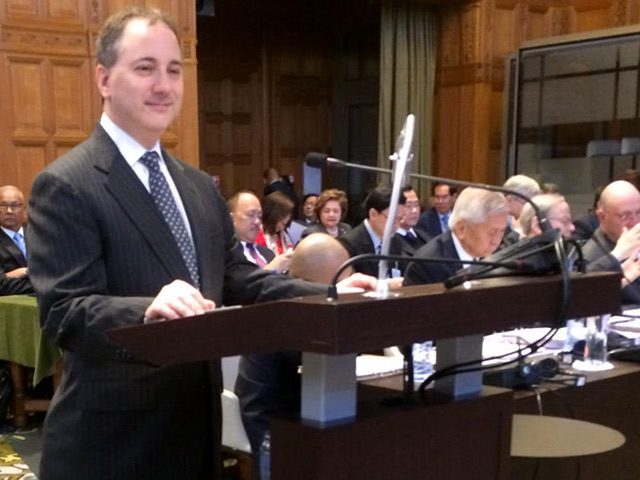SUMMARY
This is AI generated summarization, which may have errors. For context, always refer to the full article.

MANILA, Philippines – The Philippines on Thursday, November 26, said it warned a United Nations-backed tribunal that China’s island building activities have destroyed the seabed in the disputed West Philippine Sea (South China Sea).
The Philippines also slammed China for its “flagrant and persistent” violations of international law as Manila proceeded on Wednesday, November 25, with the second day of hearings on the merits of its case against Beijing.
Deputy Presidential Spokesperson Abigail Valte said that during the hearings, lawyer Andrew Loewenstein showed the tribunal satellite images “of various installations constructed by China on Mischief Reef,” found in the West Philippine Sea, among others.
“A video simulation was also shown to the tribunal to demonstrate how a cutter suction dredger destroys the seabed and transfers sand to a pre-selected area,” Valte said in a bulletin sent from The Hague, the Netherlands.
Loewenstein argued “that by engaging in these activities, China has violated the sovereign rights of the Philippines with regard to living and non-living resources” in its exclusive economic zone (EEZ) and continental shelf.
The EEZ is the area 200 nautical miles from a coastal state’s baselines, or “edges,” within which it has the exclusive rights to fish and exploit sea resources.
China has been building artificial islands to assert its claim over the West Philippine Sea. The Philippines has protested these reclamation activities.
The Philippines earlier said China’s reclamation activities have destroyed 311 hectares of coral reefs in the West Philippine Sea. That is 5 times the size of Manila’s Rizal Park.
China claim ‘hopeless, indefensible’
On the second day of hearings in The Hague, Professor Philippe Sands, another member of the Philippine team, said China interferes with the Philippines’ rights under the United Nations Convention on the Law of the Sea (UNCLOS).
Sands cited incidents wherein private companies, contracted by the Philippine Department of Energy, “were prevented from exploration” in the West Philippine Sea.
He also discussed China’s fishing ban “covering even areas in the Philippines’ EEZ.”
Philippine delegation member Lawrence Martin, for his part, presented testimonies from Filipino fishermen “to prove China’s interference in the traditional fishing activities of Filipino fishermen around the South China Sea, particularly Bajo de Masinloc or Scarborough Shoal.”
Valte said a map from 1784 “was presented to prove that Bajo de Masinloc has always been part of the Philippines.”
Loewenstein added that China’s claim over the West Philippine Sea is “hopeless and indefensible.”
A day earlier, the Philippines complained to the tribunal that China has robbed the Southeast Asian country of its right to fish in the West Philippine Sea.
Loewenstein also presented 8 maps to the tribunal, “the first of which dates back to the Ming Dynasty,” according to Valte.
These maps “show that China’s territory did not include that which it claims now under the 9-dash line,” the demarcation China uses to claim the West Philippine Sea.
This round of hearings ends on November 30. The Philippines expects a definitive ruling by 2016. – Rappler.com
Add a comment
How does this make you feel?
There are no comments yet. Add your comment to start the conversation.